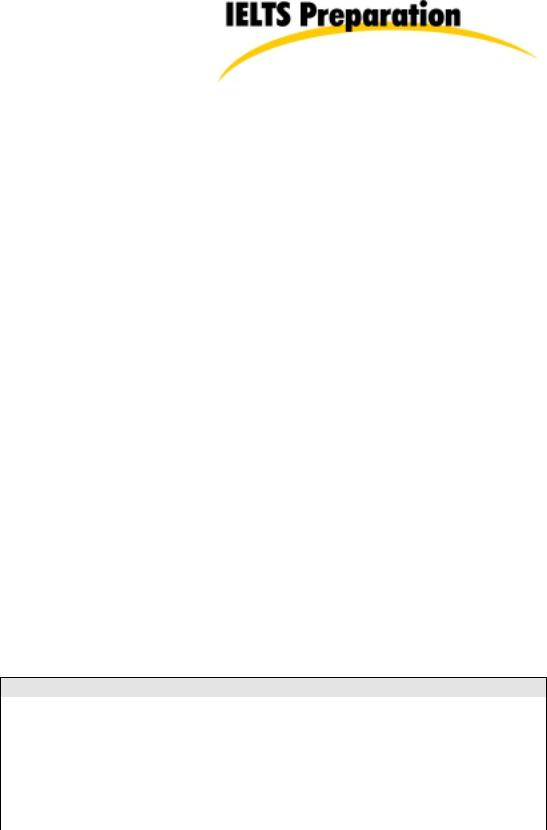
ELTS_Sample_Essays / IELTSEssays / Ielts Reading (2)
.pdf
How to approach matching headings to paragraphs
Step 1:
Step 2:
Step 3:
Step 4:
© 1999 Holmesglen Institute of TAFE |
11 |

Reading task type three: identifying the writer’s views
Task description
In this task type you will be given a number of statements. You will have to decide if these statements agree with the writer's views.
To complete this task well you will often need to be able to recognise the writer’s views not only from what is said directly, but also from what is implied. For example, we do not need the writer to state directly that he/she disapproves of zoos. We can infer this disapproval if the writer states his/her disapproval of the following: animals being taken from the wild, animals being caged, people paying money to see animals, animals not having any privacy. However, if the writer simply describes the problems with zoos this does not necessarily imply disapproval.
Also, we should not try to guess the writer’s views. In statement 5 of the sample task on the following page, we should not assume that because we think that the lifeboats should have rescued more people, or because ‘everybody’ thinks that the lifeboats should have returned to rescue more people, that this is the writer’s view. In this case the writer does not express any view on this issue; she simply states the fact that the lifeboats were not full and so the answer must be Not Given.
What is being tested is your ability to:
♦identify opinion and attitude
♦skim for detailed information
♦make inferences
© 1999 Holmesglen Institute of TAFE |
12 |

Sample task
Do the following statements agree with the views of the writer in the reading passage? In boxes 1-7 on your answer sheet write:
Yes |
If the statement agrees with the writer |
No |
If the statement contradicts the writer |
Not Given |
If it is impossible to say what the writer thinks about |
|
this |
1.The enormous loss of life on the Titanic was primarily caused by inadequate equipment, training and procedures.
2.Nobody had thought of installing enough lifeboats to accommodate all the passengers and crew in the event of an emergency.
3.Captain Smith didn’t inform his officers of the true situation because he didn’t want to cause a panic.
4.The lifeboats would have buckled if they had been fully loaded.
5.After the Titanic sank the lifeboats which were not full should have returned to rescue as many people from the water as they could.
6.The Captain of the Californian could have brought his ship to the rescue if he had realised that the Titanic was sinking.
7.The sinking of the Titanic prompted an overhaul of standard operating procedures which made ocean travel much safer.
Answer key
1. |
Yes |
2. |
No |
3. |
Not Given |
4. |
No |
5. |
Not Given |
6. |
Yes |
7. |
Yes |
© 1999 Holmesglen Institute of TAFE |
13 |

How to approach questions requiring you to identify the writer's views
Step 1:
No |
The statement contradicts the writer. |
Not Given |
The writer does not give an opinion on this |
point. |
|
Step 2: Skim through all of the statements to get an idea of the topics you will be searching for in your reading of the text.
Step 3: Read the first statement again more carefully. Note the main point or opinion given in the statement.
Step 4: Skim the text for the section which refers to that idea. If you come across information relating to other statements, put a mark beside the section so that you can find it quickly again later.
Step 5: Once you have found the appropriate section of the text, read more carefully. Decide if the statement agrees with the view of the author (mark Yes on your answer sheet) or disagrees with the author (mark No on your answer sheet). If the author doesn’t give an opinion which agrees or disagrees with the statement then mark Not Given on your answer sheet.
© 1999 Holmesglen Institute of TAFE |
14 |

Reading task type four: multiple choice
Task description
In this question type you will be given a ‘stem’ which may be an incomplete sentence or a question. The stem will be followed by three or four options – one will be correct (the answer) and three may seem possible but are in fact incorrect in some way (the distracters).
In tackling this type of question, it is very important to read the stem carefully. Candidates often make careless mistakes when they misread the stem and so choose the wrong option.
What is being tested
Multiple choice questions can be designed to test a wide variety of reading skills. The questions may require you to have an overall understanding of the main points of the text as in Question 1 of the sample task, in which case you will need to be able to read for gist. Or they may require you to have a detailed understanding of particular points as in questions 2 and 3 of the Sample Task, in which case you will need to be able to read for specific details. Multiple choice questions may also ask you to identify facts or opinions in the text.
© 1999 Holmesglen Institute of TAFE |
15 |

Sample task
Choose the appropriate letters A-D and write your answers in boxes 1-3 on your answer sheet.
1.Which is most at fault for the magnitude of the Titanic disaster?
A.The ship
B.The Titanic’s owners and builders
C.Standard operating procedure
D.The captain and crew
2.The number of lifeboats on the Titanic …
A.would have been sufficient if all boats had been filled to
capacity
B.met the regulations for much smaller ships but not the Titanic
C.had been designed in 1894 by the British Board of Trade
D.could carry more people than required under the regulations
3.The Titanic was …
A.higher than the tallest buildings of her day
B.divided into 16 watertight compartments
C.unsinkable
D.the most technologically advanced liner of her time
Answer key
1. |
C |
2. |
B |
3. |
D |
© 1999 Holmesglen Institute of TAFE |
16 |

How to approach multiple choice questions
Step 1: Read the instructions carefully
Step 2: Skim all the questions briefly to get an idea of the topics for which you will be searching when reading the text.
Step 3: Read the first question again more carefully. Decide what you will need to read to answer the question. Is the question asking you for a particular detail that you need to find in the text? Or is the question asking you for an answer which requires a global understanding of the whole text?
Step 4: Once you have decided the best strategy for dealing with the question (as above), you will need to proceed to read the text in the appropriate manner, for example reading for gist, reading for detail etc.
© 1999 Holmesglen Institute of TAFE |
17 |

Reading task type five: selecting factors
Task description
You will be provided with a number of statements some of which paraphrase or summarise what the writer said. In this task type you need to show that you know what information the writer did (and did not) mention on a particular topic.
What is being tested is your ability to:
♦skim and scan the text for details
♦understand paraphrase
♦understand inference
Sample task
The writer mentions a number of factors related to poor communication which contributed to the disaster. Which 3 of the following factors are mentioned? Write your answers (A-H) in boxes 1-3 on your answer sheet.
A.The Titanic was travelling too fast.
B.Ships were not required to operate their wireless continually.
C.There were insufficient lifeboats on the ship.
D.The Titanic’s wireless was not operating around the clock.
E.Ice warnings were not dealt with systematically.
F.The Californian’s wireless had broken down.
G.The Titanic’s wireless had broken down.
H.Captain Smith did not give his officers enough information.
Answer key
1. |
B |
2. |
E |
3. |
H |
© 1999 Holmesglen Institute of TAFE |
18 |

How to approach questions where you have to select factors Step 1:
Step 2:
Step 3:
Step 4:
© 1999 Holmesglen Institute of TAFE |
19 |

Reading task type six: table completion
Task description
You will be provided with an incomplete table which summarises or paraphrases information given in the reading text. The information in table form may be organised differently from the way in which it appears in the text, for example chronologically instead of in order of importance. The task is to complete the gaps in three words or fewer.
What is being tested is your ability to
♦skim for specific information
♦understand gist and paraphrase
Sample task
Complete the table below using information from the reading passage.
Write no more than three words for each answer. Write your answers in boxes 1-8 on your answer sheet.
Problem |
Cause of the problem |
Regulated after the |
|
|
Titanic disaster? |
|
|
(Write Yes, No or |
|
|
Doesn't say) |
Position of icebergs |
… (1) … scattered all over |
Doesn’t say |
not plotted |
the ship |
|
|
|
|
Insufficient lifeboats |
… (2) … regulations |
… (3) … |
|
|
|
Lifeboats not full |
a) ignorance of the extent |
… (4) … |
|
of the danger |
|
|
b) fear that the lifeboats |
… (6) … |
|
would … (5) … |
|
|
|
|
Californian didn’t |
No … (7) … wireless |
… (8) … |
listen to the distress |
operation |
|
calls |
|
|
|
|
|
© 1999 Holmesglen Institute of TAFE |
20 |
